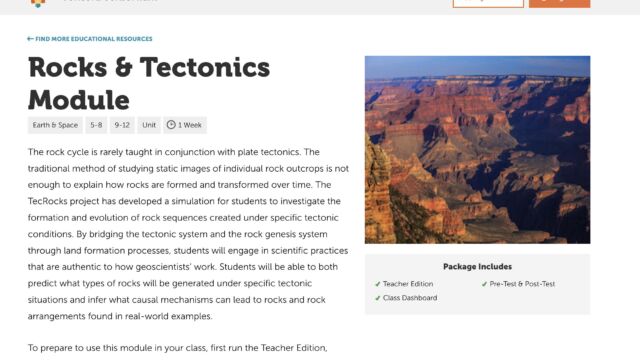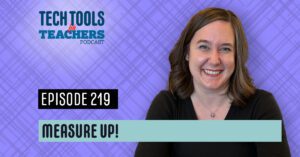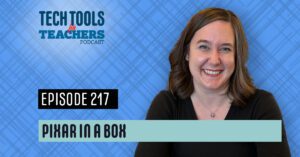[00:00:00] Shanna Martin: Thanks for listening to the Tech Tools for Teachers podcast, where each week we talk about a free piece or two of technology that you can use in your classroom. I’m your host, Shanna Martin. I’m a middle school teacher and technology instructional coach for my district.
[00:00:32] Fuzz Martin: And I am her producer and husband Fuzz Martin.
And I bring the beakers to your speakers this week. I was like, tools, teachers, podcasts, science.
[00:00:43] Shanna Martin: Wow. That was special.
[00:00:48] Fuzz Martin: Thank you. Most of the time they are pretty special.
[00:00:51] Shanna Martin: They are. Oh my goodness. So, so many things. We’re at episode 182. The school year is like, we’re there. Yeah. Like, we’re not there.
[00:01:04] Fuzz Martin: But we’re getting there.
But we’re
[00:01:05] Shanna Martin: getting there.
[00:01:07] Fuzz Martin: Pretty close.
[00:01:08] Shanna Martin: Yeah. Are
[00:01:08] Fuzz Martin: we there yet? I think that’s more likely the question right now. Are we there yet? Are
[00:01:12] Shanna Martin: we there yet? Are we there yet? Are we there yet? So many field trips happening. There’s just so many things. So, so I, I’m saying so like a thousand times,
[00:01:24] Fuzz Martin: it’s weird.
[00:01:26] Shanna Martin: So there’s one of our science teachers at my school recommended the site and use it all the time.
And I noticed it in her classroom. And I was like, What is that on your board? That looks really cool. And she’s like, it’s this really cool free resource to use. I’m like, Ooh, free resource. Tell me more. And so it’s cool. So the whole thing is based on the Concord consortium is like collected all of these cool STEM and science resources.
As a teacher, everything is offered for free. It’s free. It is so cool. So you sign and you register as a teacher and you say, I’m a teacher. And then you just have to put in there, where you’re from, like, it’ll ask you, like what school you’re from and district and things like that. You have to like be a part of a district or have a connection to a school.
And then once you do, you’re Everything is available to you and you can create a, you can create the classrooms where you’ll load your students in and then you choose the curriculum that you want to teach. And there’s so many cool collections and resources. So the teacher that I work with uses it for her genetics unit and they have all these different videos and interactives with kids.
And what’s great is kids can work through the different pieces. And it tracks what they’ve done and how they’ve answered the questions and grades it. So they earn like gems, and then like this kid, if they earn like four gems, it means that they got so many right. So they can work independently, and you can teach it, like it’s a whole curriculum, so you can teach it as a teacher, and then there’s all these different supplements that go with it.
And they’re all digital and the kids just pulled up on their Chromebooks. So you can do like the video in class together and have the discussion and go through the directions, like we’re going through our stuff on their own.
[00:03:16] Fuzz Martin: It’s gamified, which just makes it, it’s just,
[00:03:19] Shanna Martin: it’s so cool. So, and it, there’s just so many topics from boreal forest fires to, like earth science resources to evolution, to genetics, to hurricanes, to, you know, To precipitation to, I can’t even the tech rocks.
They talk about like the rocks and waters and, wildfire impacts. So you can choose like a collection. So I just picked wildfire risk and impact. It’ll tell you like, you can choose the five, eight, or it goes from like five, eight, nine, 12, choose the unit lasts about a week. Then you can run the teacher edition, which will show you like all the different pieces that the teacher is available.
So as a teacher, I can pull up the lesson, like feeling hot, hot, hot. There’s an introduction that goes with it. There’s like slides and information that goes with it. There’s an activity that goes with it and video that you show the kids gives teacher tips in there. It’ll say like, watch the video, it’ll give you the questions, and then gives you an exemplar, so you can see like, this is what we’re looking for when the kids are answering questions.
And as a teacher, you can use all of it, or you can use pieces of it, and you can apply what’s appropriate for your students. This thing goes to like the his wildfire history in the United States. Again, there’s questions that prompt it. There’s then, the images that go with it, with the slides. Like there’s just so many different pieces that you can, again, pick and choose what you want to show in your classroom.
Then there’s an activity that you can share with your students. And then you get a summary of the week. So like, these are all the different pieces. These are all the different questions. This is what kids have worked through. This is what’s happening. There’s just. So much that it offers, you can choose that.
And there’s like a classroom dashboard. So you can keep track of like, who’s doing what and what’s happening. And there’s just so many different ways that you can build these pieces into the classroom based on these cool, like very relevant science topics, which is awesome. They also have. Different guides to help you out.
So it’s like additional information and then they have modules so you can, like, there’s a pre test and there’s a post test and you can assign or you can see the teacher edition. You can print it. There’s just, oh, like unit after unit created for you as a teacher with all kinds of really cool resources.
And options for students to have access to, and as a teacher to build it from. Yeah, it’s really cool.
[00:06:02] Fuzz Martin: Good, cool.
[00:06:04] Shanna Martin: You’re like, okay.
[00:06:06] Fuzz Martin: I can’t see most of it.
[00:06:07] Shanna Martin: I know. Because you have to be a teacher to be as cool as all the other teachers are. So for an example, like if I am in the middle of, Earth and space.
You can also search by activity. So you can do like an air pollution model. You can do seismic hazards, risk. You can do assessing volcanic hazards. You can do, how do we feed a growing population? And then again, it’ll give you the assignments to go with it. So like you can choose by collection, you can choose by topic you can choose by all of these different things.
And it’s just a really cool resource for teachers
[00:06:47] Fuzz Martin: and it’s free
[00:06:48] Shanna Martin: and it’s free like everything is free about it.
[00:06:51] Fuzz Martin: That’s great.
[00:06:52] Shanna Martin: Yeah,
[00:06:52] Fuzz Martin: How do they make this all so free?
[00:06:55] Shanna Martin: It’s a great question They love teachers. Obviously. Yeah, I should point out the website. It is a learn le ar n. con cord C o n c o r d that or G So learn.
concord. org.
[00:07:11] Fuzz Martin: So, Concord is a non profit organization. They’re based in Concord, Massachusetts. Hence, Concord.
[00:07:17] Shanna Martin: I wonder if they have grapes.
[00:07:19] Fuzz Martin: I wonder if they have grapes. If you tuned in to the last episode, you’d know that grapes are a fruit. But their, their work is to help bring technology, into reality for education in science, math, and engineering.
And so I’m guessing that all these, this is just, is a part of their mission is providing this kind of content to help support STEM education.
[00:07:40] Shanna Martin: Right. And it’s awesome. Like, it’s just not one or two resources. It is a ginormous collection and super helpful for teachers across the board, with all kinds of supports, put it in resources and questions and again, just an amazing amount of information for teachers to use and share as they need to.
So it’s very cool. And I’m so glad that she pointed out to me because, cause it’s all aligned with NGSS, which is always the biggest piece too, which is the science standards and the practices. And it’s all aligned. So you know exactly what standards would go with what lesson and how to find all that too.
So I’m so glad. That it was shared with me because it’s a very cool resource and very helpful for many. So you should check it out, whether you’re a science teacher, math teacher, STEM teacher. I think that there’s a ton of resources for so many people out there.
[00:08:29] Fuzz Martin: Very good. Learn. concord. org
[00:08:34] Shanna Martin: Yes. So cool.
Yeah, I love a good resource.
[00:08:38] Fuzz Martin: There we go.
[00:08:39] Shanna Martin: So thanks for tuning in. This has been the tech tools for teachers podcast. If you ever have any questions, you can find me on the app formerly known as Twitter at smartinwi or threads. And if you want to get more information on the links to the technology and discuss this episode, you can visit smartinwi.com. If you’d like to support the show, please consider buying me a coffee or two. Visit buymeacoffee.com/smartinwi Or visit smartinwi.Com and click on that cute little purple coffee cup. Your donations help keep the show going. New episodes each week. Thanks for listening. Go educate and innovate.
[00:09:12] Fuzz Martin: The ideas and opinions expressed in this podcast in the smartinwi website are those of the author, Shanna Martin, and not of her employer. Prior to using any of the technologies discussed on this podcast, please consult with your employer regulations. This podcast offers absolutely no guarantee that these tools will work for you as described, but we hope they do.
That’s why we do this show and we’ll talk to you next time, right here on the Tech Tools for Teachers podcast.








